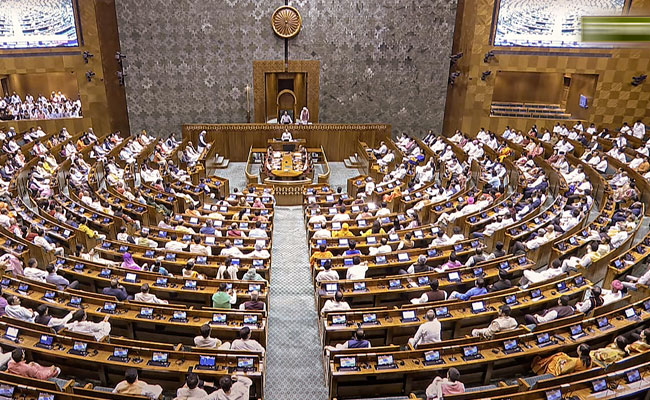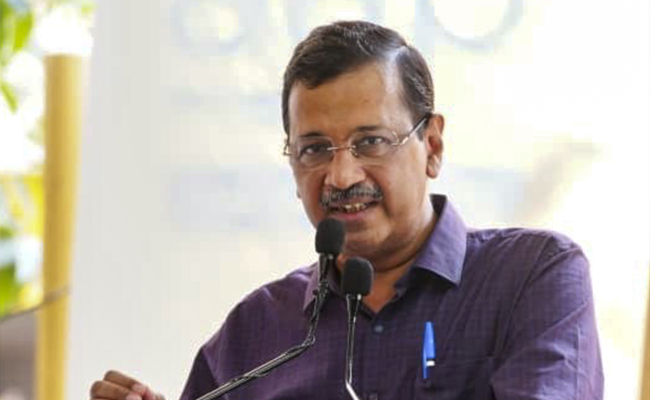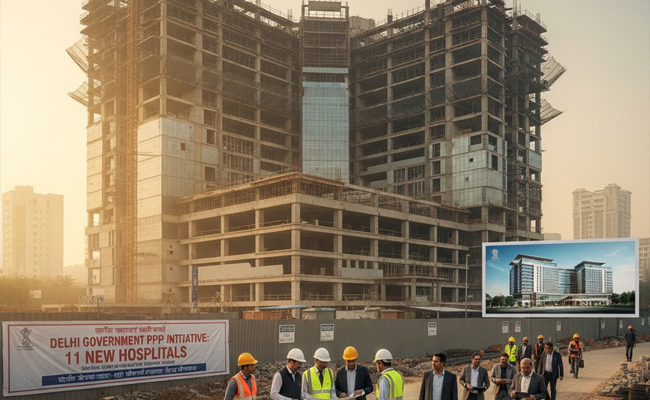New Delhi(PTI): Lok Sabha proceedings on Tuesday began in the new Parliament building, located adjacent to the old one, starting a new chapter in the parliamentary history of India.
Prime Minister Narendra Modi, who walked down from the old building along with Union Ministers including Amit Shah, Rajnath Singh, Nitin Gadkari and other leaders, was present on the occasion.
Initiating the first day of the proceedings, Lok Sabha Speaker Om Birla urged on members to set a new standard of parliamentary debate by raising people's issues, as he extended greetings of Ganesh Chaturthi, and called the move to the new parliament house a historic event.
Birla also paid his tributes to leaders who built the nation and gave India its own constitution. The new parliament building boasts of a palette of colours and architecture that takes its cue from everything Indian, from ancient to medieval.
The colour used in Rajya Sabha has been inspired by the shade of kokum red, while the look of Lok Sabha is based on Indian agave green with inspirations from the plumes of the Indian peacock.
The new Parliament building, inaugurated by Prime Minister Modi on May 28, has artwork narrating India's democratic traditions from the Vedic period to the present day.
The journey of democracy in the country is depicted through a series of exhibits in the Constitution Hall in the new Parliament building, which itself is inspired by the Sri Yantra, used for worship by many Hindus and considered a source of energy.
The building has three ceremonial foyers where huge brass images of Mahatma Gandhi, Chanakya, Gargi, Sardar Vallabhbhai Patel, B R Ambedkar, and the Chariot Wheel from the Sun Temple at Konark are on display.
The public entrances lead to three galleries -- the Sangeet Gallery which exhibits dance, song, and musical traditions of India, the Sthapthya Gallery which depicts the architectural heritage of the country, and the Shilp Gallery which showcases handicraft traditions of different states.
The interiors of the Lok Sabha chamber are based on the theme of peacock, our national bird, while that of the Rajya Sabha takes it hues from lotus, the national flower.
The four-storey Parliament House has a built up area of 64,500 sqm and has two chambers - an 888-seater Lok Sabha, which can accommodate 1,272 members for the joint sitting of both the Houses, and a 384-seater Rajya Sabha chamber.
The building opens into a central courtyard with a banyan tree. The new building also has six new committee rooms and 92 rooms for use as offices for the Council of Ministers.
There are six entry-exit points or 'dwars' in the new Parliament building, all inspired by ancient sculptures.
The Gaj Dwar has two stone elephant statues that have been inspired by statues at Madhukeshwara temple in Banavasi in Karnataka dating back to 9th century CE, while two horse statues at the Ashwa Dwar have got their inspiration from sculptures at 13th century Sun temple in Odisha.
The statues at three other dwars - Shardula, Hamsa, and Makara - are inspired by sculptures at Gujri Mahal in Gwalior, Vijay Vithala temple in Hampi, and Hoysaleswara temple in Karnataka.
The remaining Garuda dwar has as its sentinel the statues of mount (vahana) of Vishnu and have been inspired by 18th century CE Nayaka period sculpture from Tamil Nadu.
Let the Truth be known. If you read VB and like VB, please be a VB Supporter and Help us deliver the Truth to one and all.
Panaji (PTI): As part of a crackdown against tourist establishments violating laws and safety norms in the aftermath of the Arpora fire tragedy, Goa authorities on Saturday sealed a renowned club at Vagator and revoked the fire department NOC of another club.
Cafe CO2 Goa, located on a cliff overlooking the Arabian Sea at Vagator beach in North Goa, was sealed. The move came two days after Goya Club, also in Vagator, was shut down for alleged violations of rules.
Elsewhere, campaigning for local body polls, AAP leader Arvind Kejriwal said the fire incident at Birch by Romeo Lane nightclub at Arpora, which claimed 25 lives on December 6, happened because the BJP government in the state was corrupt.
An inspection of Cafe CO2 Goa by a state government-appointed team revealed that the establishment, with a seating capacity of 250, did not possess a no-objection certificate (NOC) of the Fire and Emergency Services Department. The club, which sits atop Ozrant Cliff, also did not have structural stability, the team found.
The Fire and Emergency Services on Saturday also revoked the NOC issued to Diaz Pool Club and Bar at Anjuna as the fire extinguishers installed in the establishment were found to be inadequate, said divisional fire officer Shripad Gawas.
A notice was issued to Nitin Wadhwa, the partner of the club, he said in the order.
Campaigning at Chimbel village near Panaji in support of his party's Zilla Panchayat election candidate, Aam Aadmi Party leader Kejriwal said the nightclub fire at Arpora happened because of the "corruption of the Pramod Sawant-led state government."
"Why this fire incident happened? I read in the newspapers that the nightclub had no occupancy certificate, no building licence, no excise licence, no construction licence or trade licence. The entire club was illegal but still it was going on," he said.
"How could it go on? Couldn't Pramod Sawant or anyone else see it? I was told that hafta (bribe) was being paid," the former Delhi chief minister said.
A person can not work without bribing officials in the coastal state, Kejriwal said, alleging that officers, MLAs and even ministers are accepting bribes.





